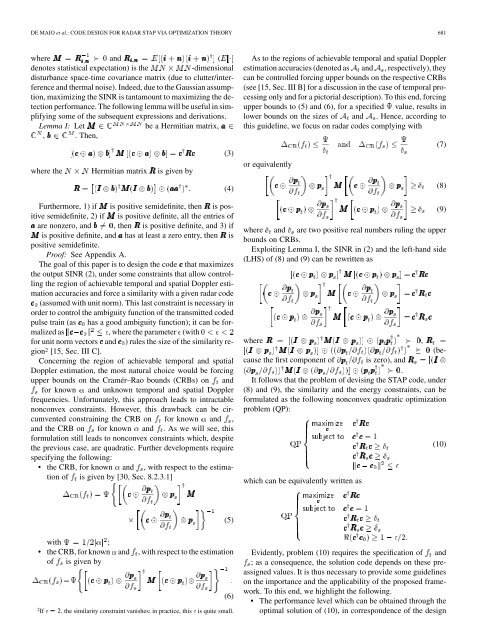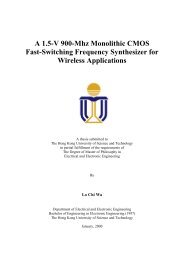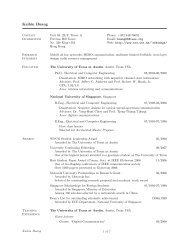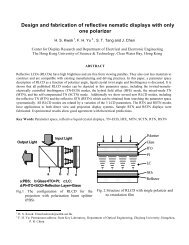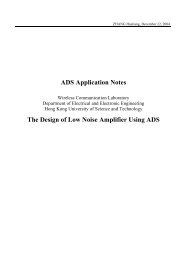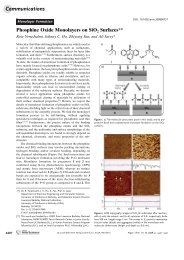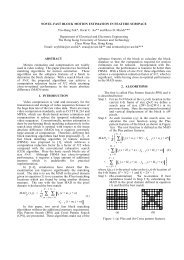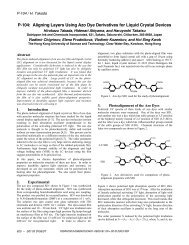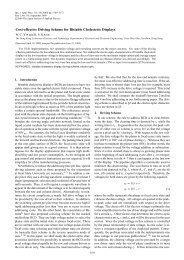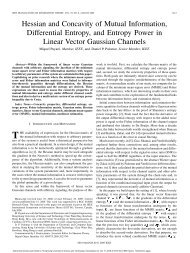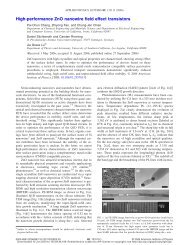680 IEEE TRANSACTIONS ON SIGNAL PROCESSING, VOL. 58, NO. 2, FEBRUARY 2010jamming, and thermal noise). The importance and the interesttowards this problem stem from the observation that radar <strong>STAP</strong>has become very popular in the past few years. Nowadays, thereare at least three excellent documents testifying the state of artin this research field: [23]–[25]. Furthermore, <strong>STAP</strong> with applicationto airborne moving target indication (MTI) radars has becomea key topic of international conferences. Last but not least,radar <strong>STAP</strong> plays an important role in numerous civilian andmilitary applications such as earth observation, surveillance,ground moving target indication (GMTI), reconnaissance, andothers [24].At the design stage, we adopt the classic <strong>STAP</strong> model of [23]and focus on transmitted signals belonging to the class of codedpulse trains. We propose a code selection algorithm which is optimumaccording to the following criterion: maximization of thedetection per<strong>for</strong>mance under a control on the regions of achievablevalues <strong>for</strong> the temporal and spatial Doppler estimation accuracy,and on the degree of similarity with a pre-fixed radarcode. Actually, this last constraint is equivalent to <strong>for</strong>ce a similaritybetween the ambiguity functions of the devised wave<strong>for</strong>mand of the pulse train encoded with the pre-fixed sequence. Theresulting optimization problem belongs to the family of nonconvexquadratic programs [16], [17]. In order to solve it, wefirst resort to a relaxation of the original problem into a convexone that belongs to the semidefinite program (SDP) class. Then,the transmitted code is constructed through the rank-one decompositiontechniques of [26], [27] and applied to an optimal solutionof the relaxed problem. Remarkably, the entire code searchalgorithm entails a polynomial computational complexity.At the analysis stage, we assess the per<strong>for</strong>mance of the newencoding algorithm in terms of detection per<strong>for</strong>mance, regionsof estimation accuracies that estimators of the temporal and thespatial Doppler frequencies can theoretically achieve, and ambiguityfunction. The analysis is conducted both on simulated dataand on the Knowledge-Aided Sensor Signal Processing and ExpertReasoning (KASSPER) [28] reference <strong>STAP</strong> datacube.The results show that it is possible to tradeoff the a<strong>for</strong>ementionedper<strong>for</strong>mance metrics. In other words, detection capabilitiescan be swapped <strong>for</strong> desirable properties of the wave<strong>for</strong>mambiguity function and/or <strong>for</strong> enlarged regions of achievabletemporal/spatial Doppler estimation accuracies.The paper is organized as follows. In Section II, we presentthe model <strong>for</strong> both the transmitted and the received codedsignal; moreover we <strong>for</strong>mulate the code design optimizationproblem. In Section III, we introduce the algorithm whichexploits SDP relaxation and provides a solution to the a<strong>for</strong>ementionedproblem. In Section IV, we assess the per<strong>for</strong>manceof the proposed encoding method also in comparison with astandard radar code. Finally, in Section V, we draw conclusionsand outline possible future research tracks.A. NotationWe adopt the notation of using boldface <strong>for</strong> vectors (lowercase), and matrices (upper case). is the thentry of the matrix . The transpose operator and the conjugatetranspose operator are denoted by the symbols and , respectively.is the trace of the square matrix argument,and denote, respectively, the identity matrix and the matrixwith zero entries, while is the vector with all zeros except 1in the th position (their size is determined from the context).The letter represents the imaginary unit (i.e., ), whilethe letter often serves as index in this paper. For any complexnumber , we use and to denote respectively the realand the imaginary parts of , and represent the modulusand the argument of , and stands <strong>for</strong> the conjugate of. The Euclidean norm of the vector is denoted by . Thesymbols and represent the Hadamard element-wise andthe Kronecker product, respectively [29]. The curled inequalitysymbol (and its strict <strong>for</strong>m ) is used to denote generalizedinequality: means that is an Hermitian positivesemidefinite matrix ( <strong>for</strong> positive definiteness).II. SYSTEM MODEL AND PROBLEM FORMULATIONThe <strong>STAP</strong> signal model adopted in this paper is that developedin [23, ch. 1], with the addition of a temporal coding on thetransmitted coherent burst of pulses. Specifically, data are collectedby a narrowband antenna array with spatial channelswhich, <strong>for</strong> simplicity, we assume colinear, omnidirectional, andequally spaced. Each channel receives echoes correspondingto the returns of a coherent coded pulse train composed ofpulses. It is assumed that the complex envelope of the transmittedsignal iswhere is the pulse repetition time (PRT),is the radar code (assumed withoutloss of generality with unit norm), is the pulse wave<strong>for</strong>mof duration and with unit energy, and are respectivelythe amplitude and the random phase of .Following [23], we <strong>for</strong>mulate the problem of detecting atarget in the presence of observables in terms of the followingbinary hypothesis test:where is the space-time snapshot at the range ofinterest, and denote respectively the clutter/interferenceand receiver noise vectors which are assumed statisticallyindependent zero-mean complex circular Gaussian vectors,is the complex amplitude accounting <strong>for</strong> both the targetas well as the channel propagation effects, and the targetspace-time steering vector, i.e.,, with( -dimensional) and ( -dimensional) being respectivelythe temporal and the spatial steering vectors. More precisely[23], ,,with and the normalized temporal and spatial Dopplerfrequencies, respectively.A common measure of a <strong>STAP</strong> processor per<strong>for</strong>mance is theoutput signal-to-interference-plus-noise ratio (SINR) [23, pp.62-69], which, <strong>for</strong> the optimum filter, is given by(1)(2)
DE MAIO et al.: CODE DESIGN FOR RADAR <strong>STAP</strong> VIA OPTIMIZATION THEORY 681where and (denotes statistical expectation) is the-dimensionaldisturbance space-time covariance matrix (due to clutter/interferenceand thermal noise). Indeed, due to the Gaussian assumption,maximizing the SINR is tantamount to maximizing the detectionper<strong>for</strong>mance. The following lemma will be useful in simplifyingsome of the subsequent expressions and derivations.Lemma I: Letbe a Hermitian matrix,, . Then,where the Hermitian matrix is given byFurthermore, 1) if is positive semidefinite, then is positivesemidefinite, 2) if is positive definite, all the entries ofare nonzero, and , then is positive definite, and 3) ifis positive definite, and has at least a zero entry, then ispositive semidefinite.Proof: See Appendix A.The goal of this paper is to design the code that maximizesthe output SINR (2), under some constraints that allow controllingthe region of achievable temporal and spatial Doppler estimationaccuracies and <strong>for</strong>ce a similarity with a given radar code(assumed with unit norm). This last constraint is necessary inorder to control the ambiguity function of the transmitted codedpulse train (as has a good ambiguity function); it can be <strong>for</strong>malizedas , where the parameter (with<strong>for</strong> unit norm vectors and ) rules the size of the similarity region2 [15, Sec. III C].Concerning the region of achievable temporal and spatialDoppler estimation, the most natural choice would be <strong>for</strong>cingupper bounds on the Cramér–Rao bounds (CRBs) on and<strong>for</strong> known and unknown temporal and spatial Dopplerfrequencies. Un<strong>for</strong>tunately, this approach leads to intractablenonconvex constraints. However, this drawback can be circumventedconstraining the CRB on <strong>for</strong> known and ,and the CRB on <strong>for</strong> known and . As we will see, this<strong>for</strong>mulation still leads to nonconvex constraints which, despitethe previous case, are quadratic. Further developments requirespecifying the following:• the CRB, <strong>for</strong> known and , with respect to the estimationof is given by [30, Sec. 8.2.3.1](3)(4)As to the regions of achievable temporal and spatial Dopplerestimation accuracies (denoted as and , respectively), theycan be controlled <strong>for</strong>cing upper bounds on the respective CRBs(see [15, Sec. III B] <strong>for</strong> a discussion in the case of temporal processingonly and <strong>for</strong> a pictorial description). To this end, <strong>for</strong>cingupper bounds to (5) and (6), <strong>for</strong> a specified value, results inlower bounds on the sizes of and . Hence, according tothis guideline, we focus on radar codes complying withor equivalentlywhere and are two positive real numbers ruling the upperbounds on CRBs.Exploiting Lemma I, the SINR in (2) and the left-hand side(LHS) of (8) and (9) can be rewritten aswhere ,(becausethe first component of is zero), and.It follows that the problem of devising the <strong>STAP</strong> code, under(8) and (9), the similarity and the energy constraints, can be<strong>for</strong>mulated as the following nonconvex quadratic optimizationproblem (QP):which can be equivalently written as(7)(8)(9)(10)(5)with ;• the CRB, <strong>for</strong> known and , with respect to the estimationof is given by2 If =2, the similarity constraint vanishes; in practice, this is quite small.(6)Evidently, problem (10) requires the specification of and; as a consequence, the solution code depends on these preassignedvalues. It is thus necessary to provide some guidelineson the importance and the applicability of the proposed framework.To this end, we highlight the following.• The per<strong>for</strong>mance level which can be obtained through theoptimal solution of (10), in correspondence of the design


